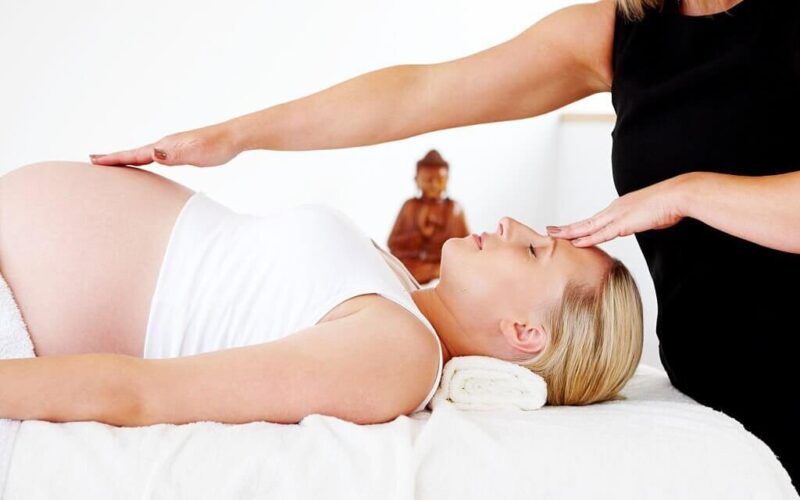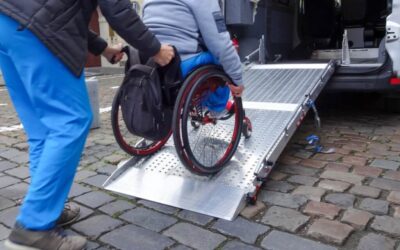Since a new human is growing inside them, women during pregnancy often feel a lot of skeletal and muscular strain. That’s why prenatal massage is crucial to reducing muscle strain during pregnancy.
The prenatal/pregnancy massage not only offers relief from minor discomforts during pregnancy, but also helps fathers-to-be to develop awareness and build a connection with their partner and the unborn child.
What is a prenatal / pregnancy massage?
Prenatal/ pregnancy massages are useful for adapting to the anatomical changes in the body during pregnancy.
The traditional massage is to spend half of the time lying on the stomach, face-down, and half the time face up.
However, as posture and shape change during pregnancy, it is not possible to massage a body the traditional way.
Therefore, you may need the help of a trained and certified massage therapist to make accommodations using special cushioning systems and equipment.
With special cushions and equipment, it becomes easier for pregnant women to lie face down without putting pressure on their growing bellies. Or you may lie comfortably on your side with the help of supportive cushions and pillows.
Safety and areas to avoid in prenatal message
The good news is that prenatal massage is safe. It is best to let your doctor know about the massage you are getting, either from a professional or your partner.
However, pregnancy massage is generally safe after the first trimester. You need to avoid massage before bed because it may make you feel nauseous or dizzy. And, you don’t want to make morning sickness worse.
Some massage practitioners don’t agree to massage in the first trimester. It is because they worry that it may even lead to miscarriage; however, there is very little evidence suggesting that.
During the first few weeks of pregnancy, it is fine just to ask your partner to massage your neck and shoulders.
Also, let your therapist or partner know if something is hurting when they are massaging you. It will let them know the right amount of pressure to put in to make you feel good.
Areas to avoid massaging during pregnancy
Massaging-specific acupressure points may trigger preterm labor or even miscarriage. There is no evidence to support this belief. Therefore, it is best to avoid specific areas on the body while passing during pregnancy.
Your pregnancy body must feel supported differently than a non-pregnant individual’s body while massaging. Proper support ensures that the baby is safe in the womb while massaging.
During the massage, it’s best to lie on the side and not on the back or stomach. Or simply sit upright or in a semi-reclining position.
Lying on the stomach is uncomfortable during pregnancy.
Furthermore, lying on the back after 20 weeks of pregnancy can put more pressure on blood vessels, including the inferior vena cava and aorta. And, this can restrict blood flow. It may even lead to blood pressure drops and reduced blood flow to the uterus.
Here are certain body parts that you need to be careful of while massaging during pregnancy:
- Your belly: You may want to avoid massaging around your growing belly. It is because it could hurt your baby and you. It’s OK to carefully rub stretch mark cream in your belly.
- Legs: It is fine to stroke or rub your legs gently. But make sure that no strong pressure is applied to the legs. It is because blood volume increases when you are pregnant and the blood flow in the legs can slow down. Massaging strongly could make you prone to clotting.
- Pressure points: In reflexology, there are certain pressure points and regions in the body, like the ankle, wrist, or between fingers. Putting pressure on such points can lead to contractions. But there is no evidence to support such claims. Nonetheless, you need to be careful while massaging any specific pressure points during pregnancy.
Preparing for prenatal massage
Here’s how you can prepare yourself for a prenatal massage:
The person giving and the one receiving the body massage must feel relaxed before beginning the process.
After the relaxed environment, you need your hands, forearms, and elbows to apply gentle pressure while massaging. Just apply slight pressure on locations where one would feel good.
Your hands generally apply the least pressure on the body while massaging. Your forearms apply medium pressure and the elbows apply acute pressure.
It also means to skip lotions or oils. It is because with oils there is a fear of massaging wrong techniques, as it can slip your hand to any wrong location. Or if you want to apply the oil, be careful.
Another important thing to consider when massaging your partner is to remain communicative and soft. Also, be ready to adjust as per the pregnant partner’s feedback. Remain adaptable to make sure things work out fine.
Benefits of pregnancy massage
According to research, massage can decrease stress hormones in the body while relaxing muscles. It even improves blood flow, which is important when you are pregnant.
This will keep the lymphatic system working at its peak efficiency. It even reconnects the body and mind while forming a comforting connection with a growing baby.
During pregnancy, regular prenatal massages also benefit you to combat:
- Joint pain
- Insomnia
- Leg cramping
- Sciatica
- Neck and back pain
- Carpal tunnel pain
- Headaches and sinus congestion
- Swelling in your hands and feet
Pregnancy massage techniques
Here are the right massage techniques to follow during pregnancy:
Technique 1: Double Hip Squeeze
This particular technique does not need any dynamic movement. It is just about applying pressure. A pregnant woman has to sit or stand on an exercise ball and lean forward at the waist with the upper body’s weight supported by a table, high bed, or counter.
The partner has to stand behind her and keep their hands on her hips and press inward to apply gentle pressure.
It helps in transforming the tissue structures that are vital during pregnancy. It even helps with reducing discomfort in the lower back, hips, and sciatic discomfort. Meanwhile, it relaxes the pelvic floor.
Technique 2: Shake the Tree
It is a more dynamic technique than a double hip squeeze. It is about movement, not pressure. Hence, this technique provides more relief.
The pregnant woman has to support the upper body on a firm surface. Her partner has to position himself just behind her while placing his hands on the inner or outer thighs.
After that, he has to gently shake or churn the thigh by gently rolling on muscle back and forth with his hands. It’s almost like forming friction when trying to fire a log.
The idea here is to softly roll the muscles around the femur axis. Those muscles begin at the pelvis. Hence, the technique is great for relaxing ligaments, the back, and the pelvic floor.
Technique 3: Lower Back Stroke
In this technique, the woman has to lean forward. And, her partner has to drag the hands from mid to lower back down to the tailbone on the spine’s either side. The partners must also complete the stroke by dragging their hands down.
Technique 4: Tailbone Press
The partner has to imagine dots on the spines each side along the tailbone. While the mom-to-be is leaning forward in a comforting position, the partner applies pressure using fingers on the imaginary dots on either side of the spine. They have to apply pressure on the top and base of the tailbone.
What does it cost?
Generally, insurance plans don’t cover prenatal massage. However, some do offer discounts. A good prenatal massage session is likely to cost between $60 and $100 for around a 30- to a 60-minute massage session. The cost varies depending on the facility and location.
Prenatal massage at home
When doing prenatal massage at home, ask your partner to follow the given tips:
Gentle foot rub: using lotion or gentle strokes, your partner can give you a gentle foot rub with slight pressure. It’s best to work from the toes towards the ankle while making small circles near the ankle.
After that, use both thumbs for making small circles on the soles just beneath the toes. Likewise, work towards the heels.
Back rub: Sit up or lay down on the side and ask your partner to use both hands for stroking up and down your back, using a lotion to smoothly glide the hands.
They need to focus on either side of the spine while kneading the muscles with the thumbs or the hand’s base.
Shoulder rub: Use the hand’s base or fingers to apply gentle pressure on the neck’s side. Also, glide between the shoulders’ top and the skull’s base.
Scalp massage: From the base of the skull to the hairline, make use of both your hands to spreading fingers for applying gentle pressure on the scalp. Also, try gentle stroking on the face for better relaxation.
Tips for pregnancy massage
Here are some general tips to follow during pregnancy massage:
1. A massage therapist must be trained well in the techniques they follow during pregnancy massage.
2. Avoid massage in the first trimester, as it may risk miscarriage.
3. Use a gentle moisturizer or olive/coconut/mustard/safflower or grape seed oil for your massage.
4. If you are allergic to certain massage oils, do tell the massage therapist about it. Or do a patch test on the skin before using a new oil for message.
5. Avoid using oils like oregano, rosemary, thyme, peppermint, sage, etc. It is because they can lead to uterine contractions.
6. Don’t press specific pressure points present in your ankles and wrists. It is because massaging them may stimulate the uterus and lead to contraction.
7. Lying on the side is a very comfortable position, particularly in the second and third trimesters. Don’t get a massage on the tables with a hole cut for accommodating a pregnant belly. It is because the cut hole can hand the abdomen and make the belly hang unsupported. This leads to the stretching of the uterine ligaments.
8. Don’t message if it makes you feel sick, light-headed, or you don’t like it.
9. Tell a massage therapist about the right pressure while massaging. It is best to ask them to use only gentle strokes or the pressure you feel comfortable with.
10. If you have diabetes, high blood pressure, or vomiting bouts, check with a doctor before getting a prenatal massage.







